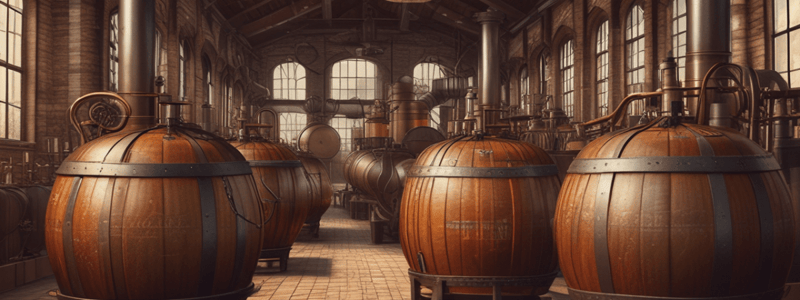Podcast
Questions and Answers
What is the primary purpose of using the extractive distillation column in the whiskey-making process?
What is the primary purpose of using the extractive distillation column in the whiskey-making process?
- To increase the ABV of the whiskey to 94%
- To create a blend of whiskey
- To add flavor to the whiskey
- To remove the fusel oils and congeners from the spirit (correct)
What is the typical proof of the spirit coming off the beer still?
What is the typical proof of the spirit coming off the beer still?
- 40% ABV
- 94% ABV
- 20-30 proof
- 130 proof (correct)
What is the primary purpose of wood management in whiskey making?
What is the primary purpose of wood management in whiskey making?
- To remove impurities from the spirit
- To create a blend of whiskey
- To increase the flavor of the whiskey
- To track the life of each barrel and sell it off after two or three uses (correct)
What is the term for the flavorless commodity alcohol that is distilled as pure as it can feasibly be done?
What is the term for the flavorless commodity alcohol that is distilled as pure as it can feasibly be done?
What is the name of the distillery that makes whiskey in a different way from the rest of Canada, using copper pot stills?
What is the name of the distillery that makes whiskey in a different way from the rest of Canada, using copper pot stills?
What is the purpose of 'marrying' the blend in another barrel?
What is the purpose of 'marrying' the blend in another barrel?
What is the percentage of the blend that can be of lesser aged spirits, American made spirits, or 'blending wine' according to the 9.09% rule?
What is the percentage of the blend that can be of lesser aged spirits, American made spirits, or 'blending wine' according to the 9.09% rule?
What is the term for the very dry white wine that is diluted and blended with grain neutral spirits?
What is the term for the very dry white wine that is diluted and blended with grain neutral spirits?
What is the typical aging process for the whiskey made by Black Velvet?
What is the typical aging process for the whiskey made by Black Velvet?
What is the term for the unwanted compounds that are removed from the spirit during the extractive distillation process?
What is the term for the unwanted compounds that are removed from the spirit during the extractive distillation process?
What is the primary purpose of the 'base whiskey' in Canadian whiskey production?
What is the primary purpose of the 'base whiskey' in Canadian whiskey production?
What is the typical proof range for 'flavoring whiskey' in Canadian whiskey production?
What is the typical proof range for 'flavoring whiskey' in Canadian whiskey production?
How do Canadian distillers approach mash conversion?
How do Canadian distillers approach mash conversion?
What is the purpose of DDG (distillers dark grain) in Canadian whiskey production?
What is the purpose of DDG (distillers dark grain) in Canadian whiskey production?
What is the ratio of corn to DDG in Canadian whiskey production?
What is the ratio of corn to DDG in Canadian whiskey production?
What is the primary benefit of using column stills in Canadian whiskey production?
What is the primary benefit of using column stills in Canadian whiskey production?
What is the purpose of extractive distillation, also known as the 'third still'?
What is the purpose of extractive distillation, also known as the 'third still'?
What is a key characteristic of Canadian distillers' approach to whiskey production?
What is a key characteristic of Canadian distillers' approach to whiskey production?
What is the typical equipment used in Canadian whiskey production for fermentation?
What is the typical equipment used in Canadian whiskey production for fermentation?
What is a key indicator of plant conditions in Canadian whiskey production?
What is a key indicator of plant conditions in Canadian whiskey production?
Study Notes
Two Streams of Whiskey
- Canadian whiskey producers create two streams of whiskey: "base whiskey" and "flavoring whiskey".
- Base whiskey is distilled to a high proof (around 94% alcohol) and is similar to grain whiskey in Scotch blends.
- Flavoring whiskey is distilled to a lower proof (between 110 and 140 proof) and is used to add flavor to the final product.
Distillation Process
- Canadian distillers use column stills to produce spirit at a rate of 240 gallons per minute.
- Malt is no longer used as a source of enzymes for mash conversion; instead, purified enzymes are used.
- The distillation process involves fermentation in closed vats, with a focus on efficiency and purity.
DDG (Distillers Dark Grain)
- DDG is a coproduct of whiskey production, used as high-protein cattle feed.
- Three tons of corn produce one ton of DDG, which is sold at a similar price per ton as the corn used to produce it.
- DDG is an indicator of plant conditions, specifically fermentation efficiency.
Extractive Distillation
- Some distillers use extractive distillation, also known as the "third still", to purify the alcohol.
- The process involves diluting the spirit to around 20-30 proof, then introducing it to an extractive distillation column to remove fusel oils and congeners.
- The resulting spirit is around 94% ABV.
Flavoring Whiskey
- Flavoring whiskey is typically made using a single pass through a pot still, similar to bourbon production.
- The whiskey is then aged in barrels, with different conditions and aging times used for different products.
Blending and Aging
- Canadian whiskey producers use a varied set of aging circumstances, including different barrel types and aging times.
- Wood management is a growing area of focus in Canadian whiskey production, with some distillers tracking barrels throughout their life and selling them off after two or three uses.
9.09% Rule
- The 9.09% rule allows Canadian whiskey exported to the US to contain up to 9.09% of "stuff", including lesser-aged spirits, American-made spirits, or "blending wine".
- Blending wine is a dry white wine diluted with grain neutral spirits (GNS) and used to add flavor to the final product.
Exceptions to the Rule
- Glenora, a malt whiskey distillery in Nova Scotia, produces whiskey in copper pot stills.
- Forty Creek, a distillery in Grimsby, produces whiskey by blending different outputs from separate grain mashes, fermentations, and distillations.
Studying That Suits You
Use AI to generate personalized quizzes and flashcards to suit your learning preferences.
Description
Learn about the unique characteristics of Canadian whiskey production, including the concept of two streams: base whiskey and flavor whiskey.




